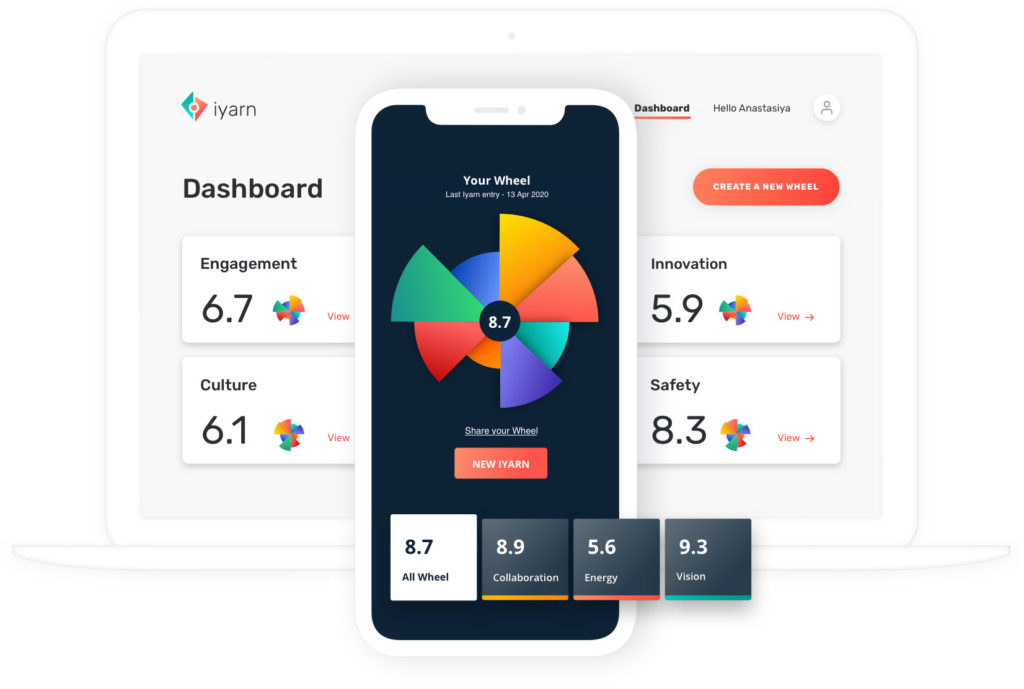How to Measure Employee Engagement for the First Time
A highly engaged workforce can be great for productivity, customer service and company performance. Unfortunately, low employee engagement has been recognised as a major issue in Australia and the United States, but particularly in the case of the UK.
So, how do you know where your company ranks? There are many way to measure employee engagement, and many companies get stuck when it comes time to make the first move.
This article will teach you how to measure employee engagement for the first time, so that you can identify the actions needed to improve your business.
What is Employee Engagement and Why is it Important?
Employee engagement concerns the commitment, involvement and enthusiasm for a company by its employees.
Engaged employees are more motivated, fulfilled, happier and healthier. They produce higher quality work, they’re better teammates and they’re less likely to leave the company. It’s for these reason that entrepreneurs like Richard Branson put so much emphasis on staff.
However, only a fraction of employees are truly engaged in their workplace. The proportion differs from country to country, with the UK around 10% and the US around 30%. That is a lot of lost opportunity!
The general consensus is that achievement, learning, recognition, feedback, belonging and control are all important factors in employee engagement, although there are many different theories.
Unfortunately, employee engagement can be tricky to quantify because it varies from business to business, country to country, even team to team. It is also heavily influenced by subjective opinions.
How can I Think About Employee Engagement in My Business?
Understanding the perspective of employees can be incredibly insightful! Consider the following areas and specific questions that relate to employee engagement.
Leadership
Do employees know and understand where the company is going? Do they trust their manager’s decision making? Do they feel leadership are great role models?
Change and Communication
Do employees understand the changes happening within the organisation? Do they feel ‘in the loop’?
Team Dynamics
Are teams in your business inclusive? Do employees spend enough time with other members of their team? Is their team a high-performing team, that inspires them to do their best work?
Operational Clarity and Support
Do employees know what needs to be done in their role? Do the systems and processes support them to do their part?
Recognition and Feedback
Are employees given feedback? How often? And do managers show recognition when employees do well?
Work-Life Balance
Do employees feel that they have enough time to do things they enjoy outside of work? Do they have work-life balance?
Career Development
Do employees feel they have appropriate growth opportunities? Are managers genuinely interested in the progression of employees? And do employees see themselves working here in two years?
Pride
Do employees feel proud to work at the company? Would they recommend a job at the company to their valued friends?
Answers to these questions can help you to get a better understanding of how employees feel about their position and the organisation. Once strengths and problem areas have been understood, action can be taken to improve the performance of weaker teams.
Which Measures Will Help Me to Understand Employee Engagement in My Business?
There are several recognised HR measures that worth considering, and you probably already have some data available in your business right now.
Labour Turnover
Labour turnover is a very crude and indirect measure of employee engagement. However, if your employees are leaving at an above average rate for your industry, it’s likely that your company’s employee engagement isn’t great.
Average labour turnover rates are about 15% in the UK, although these rates can be much higher in service industries like retailing, catering and call centres.
Unfortunately, relying on labour turnover rates to signal problems in employee engagement is generally too little, too late. By the time you see the problem, it’s already a major problem.
Absenteeism
Absenteeism is another serious consequence of low levels of employee engagement.
Average rates of absenteeism are about 2% per year, and most full time contracts have provisions that allow for up to 4% per year. It can be difficult to judge when an individual person is taking ‘fake’ sick leave, but when whole departments or teams consistently show high rates of absenteeism, then there is likely an issue.
Of course, absenteeism is an indirect measure and has some huge limits.
Employee Satisfaction
Employee satisfaction is a slightly more direct way to measure employee engagement than labour turnover or absenteeism.
While employee satisfaction can be insightful, asking questions like “do you like you work?” has several issues. It’s not truly representative of employee engagement. Your employees could be satisfied… but are they really willing to go the extra mile for the company? Would they really recommend the company to a valued friend?
Employee Net Promoter Score (eNPS)
eNPS is a helpful indicator of employee engagement. This measure asks ‘How likely is it that you would recommend this organisation as a place to work?’. Alternate variations of the questions might ask if the employee would recommend the company’s products or services.
It’s thought that because friends and family are the people we care most about, we wouldn’t recommend something to them that we don’t strongly support.
eNPS uses a scale of 0-10 which groups scores as the following:
- 9-10 are promoters. This group loves working for your organisation and will enthusiastically recommend it to others. These employees will be in extra effort to deliver more than what is required of them.
- 7-8 are passives. This group have no strong feelings about your organisation, they don’t love or hate it. They will do their work and go home, and are unlikely to talk highly about any of it to others.
- 0-6 are detractors. These employees are likely to have higher absence, lower productivity and be looking for a job elsewhere. This group would not recommend your organisation and may actively discourage friends, family and even coworkers from working there by spreading negativity such as what’s bad about the organisation and job.
The eNPS Calculation Formula subtracts the percentage of your detractors from the percentage of your promoters to give your eNPS score.
Net Promoter Score = % of Promoters minus % of Detractors
eNPS is a useful question that only take seconds to ask, but it only measures one part of employee engagement and doesn’t measure the extent of their engagement.
An employee could enjoy the work environment and therefore recommend the organisation, but may lack motivation from feeling that their manager doesn’t recognise their input.
eNPS should therefore be used in addition to other deeper questions. It does however, provide a good starting point by showing how much needs to change and how urgently.
What Approaches can I use to Measure Employee Engagement?
Getting a holistic picture of employee engagement can be complex, but the following methods can be used together to understand and measure employee engagement:
Exit Interviews
Exit interviews are structured meetings that take place when an employee is leaving the company, usually just a few days before the end of their notice period or contract end.
They provide an opportunity to learn why the individual is leaving the job, what areas of the organisation is doing well, which parts they enjoyed most, and what can be done to improve the work environment. Therefore, it’s best that the interview is conducted by someone other than the employee’s direct line manager and to check that they employee is happy to have the information shared with other management.
Exit interviews can be a very helpful tool when improving employee engagement because you’re more likely to receive honest answers from employees that are leaving than from current employees who may be worried about speaking up.
Understanding the problem areas and fixing them can aid staff retention by enabling your organisation to put an appropriate strategy in place to decrease staff turnover and costs spent on recruiting and training staff.
Additionally, exit interviews can add value to the culture of your organisation by helping you to identify trends and influencing the overall strategy and the way your organisation is perceived as an employer.
Stay Interviews
A method that is used less often but is just as useful for understanding employee satisfaction and engagement is stay interviews.
Stay interviews quiz current employees on why they continue to work for your company which means you can identify strengths and problem areas for your employees before it’s too late. The information gathered can be used to retain the current valued employees by using your new understanding to make improvements.
Compared to employee satisfaction surveys, stay interviews are recommended because they give the opportunity to ask questions about the employee’s response and delve deeper into comments that are particularly important in assessing their level of engagement.
Organisations that have a culture of open communication, trust, and employee involvement will be able to generate the most meaningful information from stay interviews. However, high staff turnover or low attendance may indicate that stay interviews aren’t the most appropriate method and instead anonymous employee satisfaction surveys may be more telling.
Stay interviews provide an opportunity to build trust with staff but you need to be committed to making positive changes following the feedback in order for them to be effective.
For that reason, it’s a good idea to notify staff that the changes were made in response to the ideas voiced in the stay interviews.
1-on-1s
Within a psychologically safe work environment one on one meetings with employees can be a really helpful way to measure engagement.
If employees feel safe, they’re more likely to open up about their work-related concerns and current emotional state.
These meetings tend to be a scheduled hour-long informal chat that facilitate a deeper understanding of how employees are doing and detailed information on any issues brought to light.
Although this method is more time consuming, it’s beneficial for each employee to attend a meeting so that engagement results aren’t skewed and they can see the organisation cares about their input.
Pulse Surveys
Pulse surveys are short surveys completed on a regular basis to track the status of a team. They consist of 5-10 questions about how an individual is feeling and if there is anything they would change.
Pulse surveys are a key tool in moving to continuous performance management. Frequently checking in with staff can have many benefits for an organisation, such as catching issues before they become more serious problems and helping to create a culture of openness and trust through team members feeling their ideas are valued.
Pulse surveys really open the door to taking timely action to improve employee engagement.
Your First Move into Employee Engagement Made Simple
iyarn has been built for quick and easy pulse surveys. Set up a survey in moments and have data flow in.
Check ins are a breeze and the insights are actionable.

Reach out to us at iyarn for a demo or start a free account to get started.




